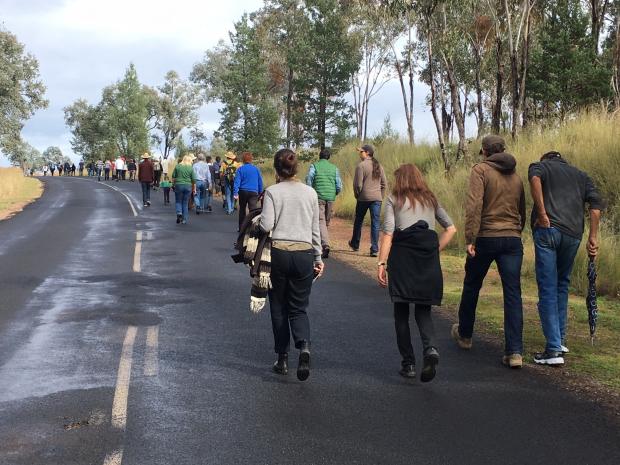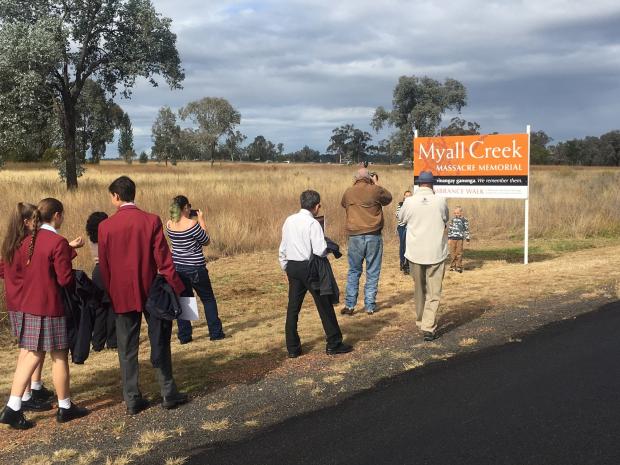In Search of Reconciliation: Remembering the Myall Creek Massacre
The killing, murder and massacre of indigenous Australians as the British settlers took their land were often known as the Frontier Wars. Few of the countless killings and only one of the many massacres that took place into the 20th century, the Myall Creek Massacre, was ever fully investigated and prosecuted.
 Each long weekend in June, Australians of Indigenous and settler descent meet at the site to make peace with the past. Aslan Shand interviews convenor Graeme Cordiner on what Myall Creek means for Australia.
Each long weekend in June, Australians of Indigenous and settler descent meet at the site to make peace with the past. Aslan Shand interviews convenor Graeme Cordiner on what Myall Creek means for Australia.
Remembering the massacre
The Weraerai people had been peacefully camped at the Myall Creek Station, in central NSW near the Gwydir River, for two to three weeks. They had moved there at the behest of their friend, Andrew Eaton, who had feared for their safety at the McIntyre’s cattle station where they were previously camped.
On the morning of Sunday, June 10, 1838, around 10 of the most abled-bodied Weraerai men set off to work at a neighbouring station to assist in cutting bark. When they arrived at the station, they learnt that armed stockmen had been there 'chasing blacks' the day before, and planned to go to Myall Creek Station that day. Realising the danger their families were in, the Weraerai men began heading back to Myall Creek Station by half past four.
They were too late. At around half past three, led by the squatter John Fleming, 11 convict and ex-convict stockmen descended on Myall Creek Station and rounded up approximately 28 unarmed Weraerai - older men, women, and children. They tied them up and then led them away to slaughter, keeping one young woman aside to be raped following the killing spree.
When the station manager, William Hobbs, returned to the station and discovered what had happened in his absence he was horrified. Local landholder Fredrick Foot was charged with reporting the atrocity to the authorities. The Muswellbrook police magistrate was absent so Foot continued onto Sydney and wrote an account of the incident for the attention of the recently arrived Governor Gipps.
Police magistrate, Edward Denny Day, was instructed to conduct an investigation that lead to 11 convict and ex-convict stockmen being arrested and taken to Sydney for trial. The leader, John Fleming, escaped into hiding and was never held to account.
George Anderson, a convict who had been assigned to work at Myall Creek Station and who had refused to join in the massacre, eventually agreed to give evidence against the stockmen who had perpetrated the crime. However, the only surviving eyewitness was not permitted to give evidence, as Aboriginal people were not allowed to give evidence in court at that time.
The first trial delivered a 'not guilty' verdict. But, in the second trial, seven of the perpetrators were tried and hanged, setting a judicial precedent in the Australian colonies.
Controversy over prosecution
Although the British government had instructed that Australian Aboriginals were to be protected, in practice, they were brutally dispossessed of their land as white settlers followed the 'explorers' into the interior of Australia. The prosecutions were unusual, and the Sydney Morning Herald at that time criticised the executions as 'judicial murder'.
At the 2017 Myall Creek memorial gathering, Australian barrister and law professor Mark Tedeschi highlighted the challenges faced by the man who successfully prosecuted the perpetrators – John Hubert Plunkett, then Attorney-General of New South Wales.
 'It was, in my view, the greatest challenge of Plunkett’s long career and one of his greatest achievements,’ said Tedeschi. ‘Unusually for the times, there were two trials that arose from the massacre, and both provoked enormous controversy and hostility throughout the colony towards the prosecutor. The powerful forces of the landowning settlers were pitted against Plunkett, and caused him endless difficulties. Plunkett’s approach to these prosecutions was innovative and bold in equal measure. He faced massive difficulties in overcoming bigotry and vested interests.'
'It was, in my view, the greatest challenge of Plunkett’s long career and one of his greatest achievements,’ said Tedeschi. ‘Unusually for the times, there were two trials that arose from the massacre, and both provoked enormous controversy and hostility throughout the colony towards the prosecutor. The powerful forces of the landowning settlers were pitted against Plunkett, and caused him endless difficulties. Plunkett’s approach to these prosecutions was innovative and bold in equal measure. He faced massive difficulties in overcoming bigotry and vested interests.'
Creation of a memorial site
 In 1965 Len Payne, a Bingara resident, proposed creating a memorial site. From the 1980s, he and friends laid a wreath at the site every June 10 in memory of those who died at Myall Creek. These humble beginnings have led to the annual Myall Creek Massacre memorial each June long weekend, when descendants of the Weraerai people killed, as well as descendants of the perpetrators, come together to remember the past.
In 1965 Len Payne, a Bingara resident, proposed creating a memorial site. From the 1980s, he and friends laid a wreath at the site every June 10 in memory of those who died at Myall Creek. These humble beginnings have led to the annual Myall Creek Massacre memorial each June long weekend, when descendants of the Weraerai people killed, as well as descendants of the perpetrators, come together to remember the past.
'It parallels the Initiatives of Change message, the need to become aware of history, accept it, and then take action out of that,' said Graeme Cordiner, convenor for Sydney Friends of Myall Creek. In keeping with these ideas, friends of Initiatives of Change Australia have been involved in marking the occasion each year.
'As Sydney friends put it – "the path to the future passes through the past" At Myall Creek this has led to a grassroots reconciliation. Clearly this operates at a deep spiritual level,' Cordiner reflected.
Currently the national committee for the Friends of Myall Creek Memorial, a mixed group of Indigenous and non-Indigenous members, are working towards the development of an education and reconciliation centre. The committee is looking to raise $15m through State and Federal funding, combined with corporate contributions and a crowdfunding campaign.
Ongoing journey of reconciliation
'Reconciliation is not a destination. It is sharing a journey, and that journey is ongoing,' said Cordiner.
'For the non-Aboriginal person it is about acknowledging history, owning it, finding forgiveness for ourselves, expressing sorrow. For Aboriginal people it is about forgiving the past. The key is the Aboriginal embrace offered without conditions, their 'welcome to country' despite all that has happened. That embrace is for us free but it is not without cost – what one banner describes as 60,000 years of Dreaming and 200+ years of nightmares.'
The education centre will focus both on the explaining the past and creating reconciliation into the future.
'This is all about identity,’ added Cordiner. ‘The only way we can belong here is by being welcomed by the original peoples. Aboriginal people are at the very centre of Australian identity, and all recent migrants are grafted into this story. Myall Creek does not exist in isolation. It is part of the massacre history of Australia that continued into the 1940s, and the new memorial will tell that story, when the blood went into the ground and cried out for justice.'
Highlighting that Australians need to work towards a treaty with the Aboriginal and Torres Strait Islander nations, Cordiner concluded: 'Until that happens we will always be treating Aboriginal people as conquered peoples, a "problem" to be fixed. But to progress beyond that, we need Treaty. Without that we will remain diminished as a nation, unable nationally to rise to the greatness of heart I have witnessed at Myall Creek.'
-
For more information on the Myall Creek Massacre, see the Friends of Myall Creek website: https://www.myallcreek.org
-
For information about Initiatives of Change Australia’s support for reconciliation in Australia, contact mike.brown@iofc.org
Photos: Justine O'Brien

